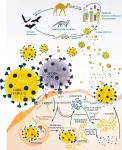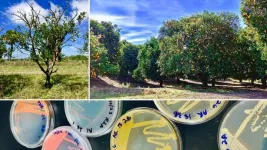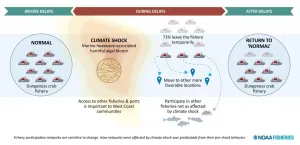Natural products with potential efficacy against lethal viruses
Review of the life histories of RNA viruses, their genetics, and the compounds that could disrupt them offers hope for curtailment of future pandemics
2021-01-05
(Press-News.org) Researchers at Scripps Institution of Oceanography and Skaggs School of Pharmacy and Pharmaceutical Sciences at the University of California San Diego have broken down the genomic and life history traits of three classes of viruses that have caused endemic and global pandemics in the past and identify natural products - compounds produced in nature - with the potential to disrupt their spread.
In a review appearing in the Journal of Natural Products, marine chemists Mitchell Christy, Yoshinori Uekusa, and William Gerwick, and immunologist Lena Gerwick describe the basic biology of three families of RNA viruses and how they infect human cells. These viruses use RNA instead of DNA to store their genetic information, a trait that helps them to evolve quickly. The team then describes the natural products that have been shown to have capabilities to inhibit them, highlighting possible treatment strategies.
"We wanted to evaluate the viruses that are responsible for these deadly outbreaks and identify their weaknesses," said Christy, the first author. "We consider their similarities and reveal potential strategies to target their replication and spread. We find that natural products are a valuable source of inhibitors that can be used as a basis for new drug development campaigns targeting these viruses."
The research team is from Scripps Oceanography's Center for Marine Biotechnology and Biomedicine (CMBB), which collects and analyzes chemical compounds found in marine environments for potential efficacy as antibiotics, anticancer therapies, and other products with medical benefit. A drug known as Marizomib entered the final stages of clinical trials as a potential treatment for brain cancers earlier in 2020. The drug came from a genus of marine bacteria that CMBB researchers had originally collected in seafloor sediments in 1990.
The researchers, funded by the National Institutes of Health and the UC San Diego Chancellor's Office, present an overview of the structure of viruses in the families Coronaviridae, Flaviviridae, and Filoviridae. Within these families are viruses that have led to COVID-19, dengue fever, West Nile encephalitis, Zika, Ebola, and Marburg disease outbreaks. The team then identifies compounds produced by marine and terrestrial organisms that have some demonstrated level of activity against these viruses. Those compounds are thought to have molecular architectures that make them potential candidates to serve as viral inhibitors, preventing viruses from penetrating healthy human cells or from replicating. The goal of the review, the researchers said, was to improve the process of drug development as new pandemics emerge, so that containing disease spread can accelerate in the face of new threats.
"It is simply common sense that we should put into place the infrastructure necessary to more rapidly develop treatments when future pandemics occur," the review concludes. "One such recommendation is to create and maintain international compound libraries with substances that possess antiviral, antibacterial, or antiparasitic activity."
To achieve that goal, the researchers realize that international agreements would need to be reached to address intellectual property issues, the rights and responsibilities of researchers, and other complex issues.
And while there has been remarkable progress in the development of vaccines for SARS-CoV-2 infection, effective antiviral drugs are also critically needed for managing COVID-19 infection in unvaccinated individuals or in cases where the efficacy of a vaccine decreases over time, the researchers said. While several candidate antiviral molecules have been investigated for use in the clinic, such as remdesivir, lopinavir-ritonavir, hydroxychloroquine, and type I interferon therapy, all have shown limited or no efficacy in large scale trials. Effective antiviral drugs are still much in need of discovery and development.
INFORMATION:
[Attachments] See images for this press release:

ELSE PRESS RELEASES FROM THIS DATE:
2021-01-05
BUFFALO, N.Y. - The human body is filled with friendly bacteria. However, some of these microorganisms, such as Veillonella parvula, may be too nice. These peaceful bacteria engage in a one-sided relationship with pathogen Porphyromonas gingivalis, helping the germ multiply and cause gum disease, according to a new University at Buffalo-led study.
The research sought to understand how P. gingivalis colonizes the mouth. The pathogen is unable to produce its own growth molecules until it achieves a large population in the oral microbiome (the community of microorganisms ...
2021-01-05
The human papillomavirus infection, or HPV, is the most common sexually transmitted infection in the U.S., according to the Centers for Disease Control and Prevention. HPV is associated with health problems including genital warts and cancers, but a vaccine has been available since 2006 to help stop the virus. The CDC reports more than 12 years of data supports the HPV vaccine is safe and effective, yet HPV vaccination rates across the U.S. still remain low.
Social media has a history of being a popular place for sexual health discussions, and the HPV vaccine is one of the most discussed vaccines on the internet. Monique Luisi, an assistant professor in the University of Missouri School of Journalism, has studied more than 6,500 public HPV vaccine-related posts ...
2021-01-05
While humanity is facing the COVID-19 pandemic, the citrus industry is trying to manage its own devastating disease, Huanglongbing (HLB), also known as citrus greening disease. HLB is the most destructive citrus disease in the world. In the past decade, the disease has annihilated the Florida citrus industry, reducing orange production for juice and other products by 72%. Candidatus Liberibacter asiaticus (CLas) is the microbe associated with the disease. It resides in the phloem of the tree and, like many plant pathogens, is transmitted by insects during feeding events. Disease progression can be slow but catastrophic. Symptoms begin with blotchy leaves, yellow shoots, and stunting, ...
2021-01-05
BOSTON -- Getting control of COVID-19 will take more than widespread vaccination; it will also require better understanding of why the disease causes no apparent symptoms in some people but leads to rapid multi-organ failure and death in others, as well as better insight into what treatments work best and for which patients.
To meet this unprecedented challenge, researchers at Massachusetts General Hospital (MGH), in collaboration with investigators from Brigham and Women's Hospital and the University of Cyprus, have created a mathematical model based on biology that incorporates information ...
2021-01-05
Diabetes continues to be the leading cause of new cases of blindness among adults in the United States. But the current shortage of eye-care providers would make it impossible to keep up with demand to provide the requisite annual screenings for this population. A new study looks at the effectiveness of seven artificial intelligence-based screening algorithms to diagnose diabetic retinopathy, the most common diabetic eye disease leading to vision loss.
In a paper published Jan. 5 in Diabetes Care, researchers compared the algorithms against the diagnostic expertise of retina specialists. Five companies produced the tested algorithms - two in the United States (Eyenuk, Retina-AI Health), one in China (Airdoc), one in Portugal (Retmarker), ...
2021-01-05
Fishermen contend with regulations, natural disasters, and the ups and downs of the stocks they fish, along with many other changes. As a result, fishing communities are quite resilient. That is, they can withstand, recover from, and adapt to change.
But how much pressure can they stand? The 2014-2016 North Pacific marine heatwave, known as the Blob, led to a harmful algal bloom of unprecedented scale. It necessitated substantial delays in the opening of the 2015-16 U.S. West Coast Dungeness crab fishery. The fishery is vital to West Coast communities. It produces around 26 percent of all annual fishing revenue and supports more than 30 percent of all commercial fishing vessels.
Understanding ...
2021-01-05
Humans have consumed different types of fermented foods - from kimchi to yogurt - for thousands of years. Yet only recently, with the availability of new scientific techniques for analyzing their nutritional properties and microbiological composition, have scientists begun to understand exactly how the unique flavors and textures are created and how these foods benefit human health.
Now, 13 interdisciplinary scientists from the fields of microbiology, food science and technology, family medicine, ecology, immunology, and microbial genetics have come together to create the first international consensus definition of fermented ...
2021-01-05
Hotel managers have something in common beyond their reputations for charming dispositions and excellent listening skills - they're predominantly men, despite women making up the majority of the accommodations workforce. New research led by the University of Houston Conrad N. Hilton College of Hotel and Restaurant Management suggests hotel companies that promote a woman over an equally qualified man are perceived as fairer and less discriminatory, creating a stronger organizational culture and higher financial performance.
Published in the International Journal of Contemporary Hospitality Management, the study is the first to address gender inequity in promotional opportunities for hotel employees. The researchers surveyed 87 hotel ...
2021-01-05
DENVER/January 5, 2020 - Some English bulldogs diagnosed with a common cancer may instead have a newly described, non-cancerous syndrome called polyclonal B‐cell lymphocytosis. The discovery was made by Morris Animal Foundation-funded researchers at Colorado State University during a study to better understand B-cell chronic lymphocytic leukemia (BCLL). The team published their findings in the Journal of Veterinary Internal Medicine.
"This could save some dogs from being misdiagnosed, treated for cancer or even euthanized when they shouldn't be," said Dr. Anne Avery, Professor, Department of Microbiology, Immunology and Pathology at Colorado State University. "The dogs may look to their veterinarians like they ...
2021-01-05
BOSTON - (January 4, 2021) - As they age, people with diabetes are more likely to develop Alzheimer's disease and other cognitive disorders than are people without diabetes. Scientists at Joslin Diabetes Center now have shown that routine eye imaging can identify changes in the retina that may be associated with cognitive disorders in older people with type 1 diabetes.
These results may open up a relatively easy method for early detection of cognitive decline in this population, providing better ways to understand, diagnose and ultimately treat the decline, said George L. King, MD, Joslin's Chief Scientific Officer and senior author on a paper about the study in the Journal of Clinical Endocrinology & Metabolism.
Previous research had demonstrated an association ...
LAST 30 PRESS RELEASES:
[Press-News.org] Natural products with potential efficacy against lethal viruses
Review of the life histories of RNA viruses, their genetics, and the compounds that could disrupt them offers hope for curtailment of future pandemics






